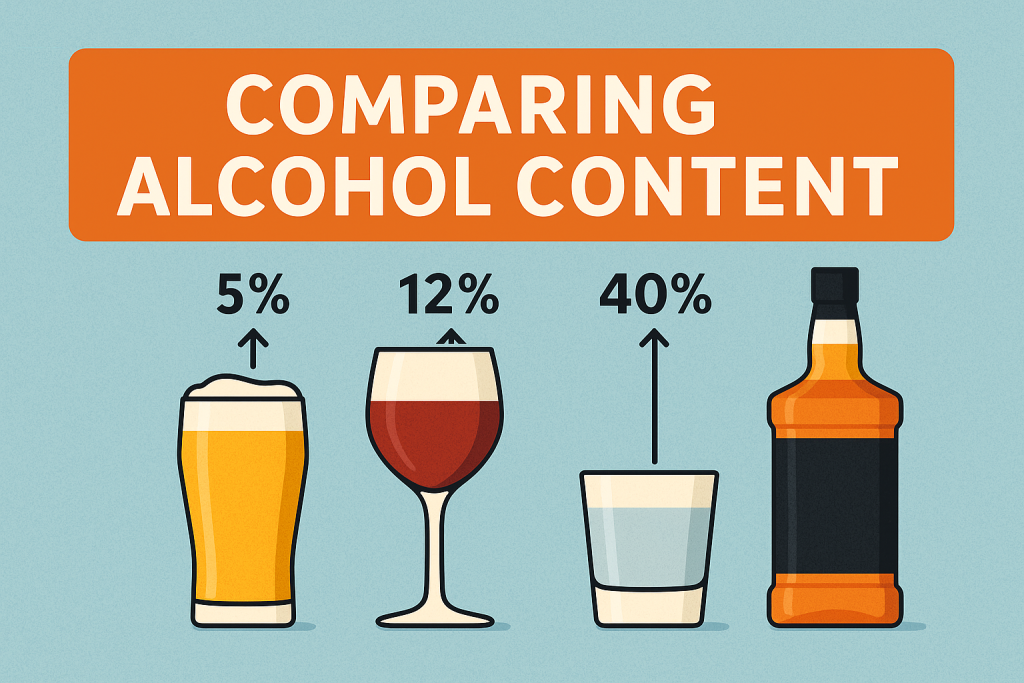Introduction: Why Alcohol Content Matters
Comparing alcohol content in different drinks like beer, wine, and spirits is essential for anyone who wants to drink smart and stay healthy. Not all alcoholic beverages contain the same amount of alcohol, even if the serving sizes look similar. Knowing how to measure and compare alcohol content helps you make informed decisions, avoid overconsumption, and enjoy your drink responsibly.
Understanding and comparing alcohol content can help you:
- Drink responsibly
- Avoid overconsumption
- Make better choices for your health and lifestyle
In this article, we’ll dive deep into how various alcoholic drinks stack up in terms of alcohol strength and how to compare them accurately.
1. What is ABV? (Alcohol by Volume)
Alcohol by Volume (ABV) is the standard measure used globally to quantify how much alcohol is present in a beverage. It’s expressed as a percentage.
- Example: A wine with 12% ABV means 12% of the liquid is pure alcohol.
Here’s a quick reference:
| ABV (%) | Strength Category |
|---|---|
| 0–1% | Non-alcoholic |
| 1–4% | Light Alcohol |
| 4–7% | Beer Range |
| 8–15% | Wine Range |
| 20–40% | Spirits Range |
2. Alcohol Content Comparison Table
| Beverage Type | Average ABV (%) | Standard Serving | Alcohol Content per Serving |
|---|---|---|---|
| Light Beer | 3.5–4.5% | 12 oz (355 ml) | ~0.42 oz (12.5 ml) |
| Regular Beer | 5% | 12 oz | ~0.6 oz (17.7 ml) |
| Craft Beer | 6–9% | 12 oz | 0.72–1.08 oz |
| Wine | 11–14% | 5 oz (148 ml) | ~0.6 oz (17.7 ml) |
| Fortified Wine | 15–20% | 3.5 oz (103 ml) | ~0.7 oz (20.7 ml) |
| Vodka / Gin | 40% | 1.5 oz (44 ml) | ~0.6 oz (17.7 ml) |
| Whiskey | 40–50% | 1.5 oz | 0.6–0.75 oz |
| Liqueurs | 15–30% | 1.5 oz | 0.23–0.45 oz |
✅ Takeaway: One standard drink contains around 0.6 ounces (17.7 ml) of pure alcohol, regardless of the beverage type.
3. Beer vs Wine vs Spirits: What’s Stronger?
Beer
- Light and refreshing
- Lower ABV (3.5%–7%)
- Safer for long sessions but can lead to overconsumption due to quantity
Wine
- Moderate ABV (11%–14%)
- Consumed slowly
- Can cause faster intoxication than beer due to higher concentration
Spirits
- Highest ABV (35%–50%)
- Small serving sizes
- Fastest intoxication, higher risk for binge drinking
4. Understanding Standard Drinks (U.S. Guidelines)
According to the National Institute on Alcohol Abuse and Alcoholism (NIAAA):
A standard drink in the U.S. contains about 14 grams of pure alcohol, found in:
- 12 oz of beer (5% ABV)
- 5 oz of wine (12% ABV)
- 1.5 oz of spirits (40% ABV)
🔗 Source: NIAAA – What is a Standard Drink?
5. Alcohol Content in Cocktails
Cocktails can be tricky since they often mix several alcoholic ingredients. A single margarita or Long Island Iced Tea can contain:
- 2–3 standard drinks
- ABV between 12% and 25%
🔍 Tip: Always ask the bartender or check the recipe to estimate the ABV.
6. Non-Alcoholic vs Low-Alcohol Beverages
With the rise of mindful drinking, non-alcoholic (under 0.5% ABV) and low-alcohol drinks (1%–3% ABV) are gaining popularity.
Popular options:
- Heineken 0.0
- Seedlip (non-alcoholic spirits)
- Light wines (under 8% ABV)
7. Global Alcohol Content Standards
Different countries have their own ways of measuring and labeling alcohol. Here’s a quick comparison:
| Country | Standard Drink (grams of alcohol) |
|---|---|
| USA | 14 g |
| UK | 8 g (1 unit) |
| Australia | 10 g |
| Japan | 19.75 g |
🔗 Source: World Health Organization
8. Why Comparing Alcohol Content Helps Your Health
Understanding ABV and standard drinks empowers you to:
- Prevent over-drinking
- Know your limits
- Choose lighter options
- Avoid dangerous combinations (e.g., mixing spirits and energy drinks)
📌 Did you know? Mixing alcohol with energy drinks masks the feeling of intoxication, increasing the risk of alcohol poisoning.
9. Alcohol Content & Weight Gain
The higher the ABV, the more calories a drink usually has. Example:
- Light beer (3.5% ABV): ~100 calories
- Regular wine (12% ABV): ~125 calories per glass
- Whiskey (40% ABV): ~105 calories per shot
💡 To drink smarter, compare ABV + calories per serving before choosing.
10. Practical Tips for Smart Drinking
- 🍺 Alternate alcohol with water
- 🧠 Know your ABV before you pour
- 🍷 Use measuring tools for home drinks
- 🍸 Don’t eyeball—1.5 oz = one shot
- 📱 Use apps like “Drinkaware” to track intake
11. Alcohol Content Myths Debunked
❌ Myth 1: “Beer gets you less drunk than vodka.”
✅ Truth: 3 beers = 3 shots in alcohol content.
❌ Myth 2: “You can’t get drunk on wine.”
✅ Truth: A bottle of wine = ~5 standard drinks!
❌ Myth 3: “Light beer means alcohol-free.”
✅ Truth: Light beer has fewer calories, not zero alcohol.
12. Conclusion: Make Every Drink Count
Comparing alcohol content isn’t just for bartenders or connoisseurs. It’s a life skill that helps you stay in control, enjoy social settings, and protect your health. Whether you love a glass of red wine or a cold craft beer, knowing your ABV is key.

